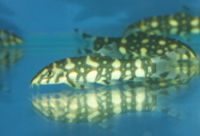How To Care For Polka Dot in a shop tank
Polka Dot fish are captivating freshwater species that add charm to any aquarium. They are known for their striking pattern and playful behavior. Proper care is essential for their well-being and longevity.
To thrive, Polka Dot fish require a spacious tank with plenty of hiding spots. They are active swimmers and benefit from a well-structured environment that mimics their natural habitat. A substrate of smooth gravel or sand is ideal, as it prevents injury to their sensitive bodies.
Maintaining water quality is crucial for Polka Dot fish. They prefer a temperature range of 72-78°F (22-26°C) and a slightly acidic to neutral pH level between 6.5 and 7.5. Regular water changes help keep the environment clean and safe, reducing stress and potential health issues.
These fish are social and thrive in groups, so consider keeping them with compatible species. Their playful nature and curious behavior make them a delight to observe, contributing to a lively aquarium atmosphere. Providing a balanced diet of high-quality flakes, pellets, and occasional treats will ensure they remain healthy and vibrant.
Polka Dot in a shop tank is a fascinating aquarium fish that stands out with its vibrant colors. It belongs to the family Cobitidae and is native to the Asia.
This species has a care level of Moderate and requires a minimum tank size of 114 Litres (30 US G.). It typically reaches a size of 10-12 cm (3.9-4.7").
Preferred water parameters include a specific gravity (sg) of Freshwater, pH ranging from 6.8 - 8, and a temperature between 24 -28 °C (75.2-82.4°F). Additionally, maintaining water hardness within the range of 2-10 °d is essential.
For stocking, the recommended ratio is 1:1 M:F. The Polka Dot in a shop tank is widely available and has a diverse diet that includes OmnivorePellet FoodsFlake FoodsLive FoodsOther (See article).
With a life span of 3-4 years, this species is known for its very easy care requirements. It is an ideal choice for both beginner and experienced aquarists. Providing a well-maintained tank environment with suitable water conditions will ensure the health and vibrancy of this captivating species.

